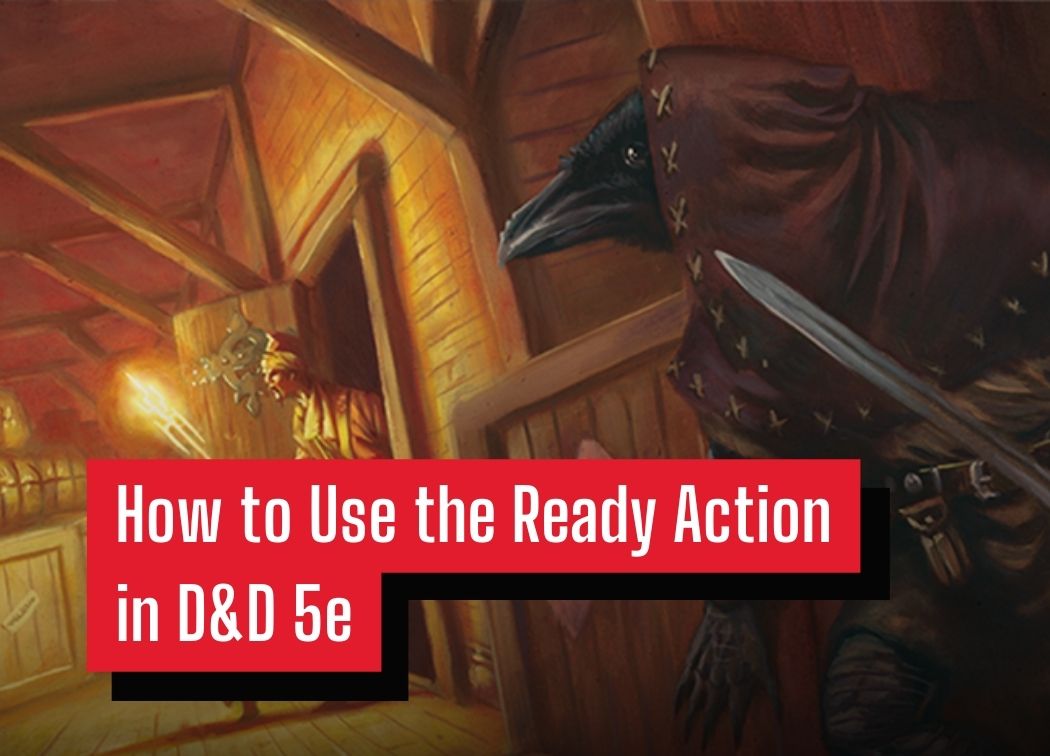How to Use the Ready Action in D&D 5e

It’s no secret that I’m a huge fan of how combat works in D&D 5e. There are so many powerful and meaningful decisions to make in any given round of combat. I love that each character or creature can do multiple things on any given turn.
What it boils down to is that I love making tactical decisions in combat and I’m sure it rubs off a lot in my encounter design. D&D 5e has made it a point to give us plenty of opportunities to make choices and use our wits to gain the upper hand in combat.
For example, using the environment to gain cover from ranged attacks. Ducking behind a tree or a low wall to take pot-shots at the enemy archer is way more interesting than just attacking in an open field and rolling some dice. It’s fun when games reward you for making interesting decisions from a role-playing and mechanical perspective.
The Ready action is yet another way to use strategy to outmaneuver your opponent. It’s unique in particular because it allows you to hold your action on your turn and use it at another point in the combat round.
This may not sound useful at first, but after a few combat encounters under your belt, you’ll surely see the value in it. It’s not always advantageous to go before everyone else. There are plenty of cool combos your party can pull off if you have some patience.
Mechanics of a Ready Action
The Ready action is the only RAW (rules as written) action that requires both an action and a reaction to use. This is going to do a number on your action economy, but the risk is worth it when used properly.
There are two parts to a Ready action: declaring a trigger and reacting to the trigger. For starters, a trigger is a specific event that will cause your character to do something to react to the event.
Think of it like this, your Ready action needs to have two statements. An “if” statement and a “then” statement.
One example of this is “if the gnoll opens the door then I’ll shoot him with my longbow”. Because the gnoll opened the door to the room you shot him with an arrow.
Let’s dig a bit deeper now that we have a basic understanding of what the Ready action is. How exactly does this all work?

Declaring a Trigger
First, you need to declare a trigger. This needs to be a perceivable circumstance that could engage a reasonable response from your character. You want your trigger to be something that will make sense in the battle.
Technically it doesn’t have to be a specific scenario. A trigger could technically be “if the cleric moves I shoot the goblin”, but what’s the point of that? You essentially used an action and a reaction to do what you would’ve done as an action. It’s better to use something the enemy does and turn it against them.
The action that you take because of the trigger also has to be declared at this time. This action can be any typical action you could normally make on your turn.
However, it must be an action, not a bonus action. Casting Healing Word isn’t a valid choice for a Ready action. Though, you could certainly cast that on your turn and then take the Ready action.
Mechanically, this means that you are using your action to hold onto your action until the trigger happens. If the trigger doesn’t happen you’ll lose your action. This is the risk of using the Ready action and is why you’ll want to think carefully about what has a good chance of happening in this round of combat.
Reacting to the Trigger
Once the trigger happens you are given a choice. You can either use your reaction to follow through with the original decision you made when you used the Ready action, or you could forego your reaction and do nothing.
This is where the risk comes in with the Ready action. Holding your action may not have worked out as you had intended and you end up wasting an action. You are also in danger of wasting your action if the trigger never ends up happening.
This is why it’s integral you pick a reasonable trigger that has a high chance of happening but is specific enough to be strategically valuable to delay your turn.
You can also choose to use movement instead of a typical action, but this must have been declared as part of the original trigger. An example of this would be “if an enemy steps next to me I move behind the crates”. You do not get to amend your trigger, so tough luck if you said you’d attack but you’d prefer to move.
Using a Ready Action to Attack
You can use any regular action as a Ready action. This could be using an item such as closing a door, or it could be using the Help action to give an ally advantage before they attack. The possibilities are endless.
That being said, the vast majority of the time that the Ready action is used is to make some type of delayed attack. You can make either a regular weapon attack or a spell attack if you’re able to. The only catch is that the attack has to use an action. Again, no bonus action attacks like a spell or an off-hand weapon attack.
Weapon Attack
You may choose to make a weapon attack as a reaction if you declared it as part of your Ready action. Weapon attacks are still at the limitations of their normal ranges.
The character making a weapon attack can only make a single weapon attack according to RAW even if they have the Extra Attack feature. This is fair since it’s a reaction, narratively it’s meant to be a quick action like an opportunity attack.
This feels a bit cheap though at first glance. You’re giving up your action that you could typically make multiple attacks with for just a single attack. This is why it’s balanced. You are ideally choosing a strategic moment where giving up these extra attacks for a single strike.
That being said, I haven’t had much of an issue allowing my players to use their Extra Attack feature during a Ready action. They’re still sacrificing a reaction to do so. As long as your players don’t abuse it, I don’t find this to be a game-breaking homebrew ruling.
Rogues work well with Ready action since they can use their sneak attack once per turn not per round. They also don’t miss out on a whole lot offensively speaking since they don’t have Extra Attack. Though, using their reaction in this way would force them to give up a potential use of Uncanny Dodge.

Spells
Holding a spell is extremely risky and is part of the reason why only a single weapon attack is balanced. To hold any spell you have to maintain concentration starting at the moment you declare the Ready action. Not only this, but you have to cast the spell at the start of the Ready action and hold it.
This means that if you a) lose concentration, b) ignore the trigger, or c) chose a trigger that didn’t occur, you’ll consume the spell slot without casting the spell.
Since this requires concentration, the spellcaster will be unable to maintain concentration on a spell they cast before their Ready action. Even casting a cantrip as part of a Ready action requires concentration. It’s a serious decision for a caster to hold their action like this.
You’ll then release the spell as a reaction if your trigger happens and you decide to act on it.
Unique Spell Interactions with the Ready Action
Speaking of spells, one cool thing to note is that Eldritch Blast is extremely powerful when used as a Ready action. This is because it’s one of the few RAW legal ways to make multiple attacks as a reaction.
Another spell that interacts differently with spells cast as a Ready action is Counterspell. Per a recent rules clarification by Jeremy Crawford, the Counterspell will counter the spell that is cast as part of your action, and not when the spell is released on your reaction.
This is so that the spellcaster doesn’t lose both an action and a reaction when casting a spell using a Ready action. It would be a slight buff to Counterspell to be able to negate both a creature’s action and reaction in this scenario, and frankly, Counterspell doesn’t need a buff.
When to Use the Ready Action
There are a lot of risks to consider when you decide to use the Ready action. However, that’s because it can be an amazing strategic choice.
That being said, it’s a bit of a niche action. You’re giving up your action economy to make fewer attacks, or you’re risking a spell slot and concentration to attempt the perfect spell cast. This isn’t something you’re going to be doing often.
Here are some situations where using the Ready action instead of an action can be the better tactical decision.
Setting Up a Combo with an Ally
As a rogue, you may want to hold your action until an ally has engaged the enemy so you can benefit from sneak attack. You could use a Ready action and have it trigger when an enemy runs into the range of an ally, or have it trigger when an ally gets into melee range of the enemy.
Figure out which trigger is the better option and then declare it as a Ready action. This way, when your ally goes in to strike you can team up together and deal some hefty damage at once.
A classic example of a Ready action combo is for the party to aim their ranged weapons and spells at the door. The trigger for this instance is for when an enemy opens the door they’ll be immediately shot at. This is a great way for your party to stay safe in a room while still dealing some solid damage to the enemy.
There are plenty of interesting combinations that your party can come up with when Ready actions are involved.
Striking at the Ideal Time
Sometimes you don’t want to go first in the initiative order. You may have a powerful AoE spell that you’d love to drop on top of a group of enemies. However, your turn is before the barbarian’s who is in the middle of the group.
This is the perfect opportunity to use a Ready action to hold your spell while you wait for your ally to move. In this case, your trigger would be the following, “I cast Ice Storm after Carl moves away”. You can then launch your icy assault after Carl has made his way to safety.

The risk with this, of course, is if Carl doesn’t move out of the way you don’t cast the spell at all. That being said, you’re patiently waiting until the opportune moment to strike, and taking a risk to do so, most people will comply.
This is a perfect example of waiting to strike until the ideal opportunity presents itself. It may be efficient to drop the big AoE on the party to destroy the enemy, but it isn’t ideal.
Waiting to See the Opposing Force’s Intentions
There are plenty of occasions in D&D and other RPGs where the opposing forces in combat aren’t the enemy. The party may have found themselves in a precarious situation and needs a little more time to try to diffuse the situation. The combat encounter could also just be a misunderstanding, and neither side wants to strike first.
Whatever the reason, it may be best to take a defensive Ready action if you do not know the opposing force’s true intentions. Perhaps the target is digging through their pockets for an important letter and not a weapon like you first thought.
It’s perfectly reasonable to declare a Ready action with a trigger of “if the target attacks, I shoot them with my hand crossbow”. You’re waiting for them to make the first move before out-right attacking someone who may not even be an enemy.
Conclusions
A Ready action is a strategic tool that allows the player to delay their action until later in the round. This can be used to help set up combos, take advantage of the perfect opportunity, or even to buy more time to suss out the opposition.
It’s a big risk to use a Ready action as it takes away both your action and reaction for that turn. Casting a spell is even more costly as it requires concentration and consumes the spell slot on your turn. That being said, when you pull off a clutch maneuver by using a Ready action the risk will have been worth it.
If you’re interested in learning more about the Ready action look no further than page 193 of the Player’s Handbook. The official rules and mechanics are all written out there, and the rest of the different actions all have their rules in that chapter as well.

Several of your examples are incorrect since Readied Actions don’t exist outside of combat. There has to be an established initiative order for you to ready an action. So “if the target attacks” or waiting for a door to be opened don’t work as readied actions if no initiative order has been established.
If you are a rogue wanting to use the Ready action to make a sneak attack once the sides have closed, I don’t believe you would have to choose between whether the enemy engages your ally or vice versa. You could instead just set the condition that “I fire my arrow at the enemy as soon as they are in melee range with my ally”. It won’t matter which one moved to meet the other, either way you can take the sneak attack shot.